Home » Blogs
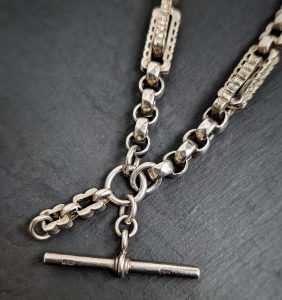
One hundred & fifty years ago, the Albert chain was an essential accessory for the majority of society. Both decorative and practical, the Albert chain was an integral part of the Victorian ensemble, and a permanent feature in jewellery shop windows.
Designed to be worn with a waistcoat, the Albert chain would carry a pocket watch at one end, and would attach to the buttonhole of a waistcoat at the other. This made accessing the pocket watch from the waistcoat pocket far easier whilst preventing it from being dropped – rather like a large safety chain. Alongside this, a small length of chain hung down from the buttonhole, and from this would often hang a fob. Fobs typically held an intaglio seal, carved into metal or precious stone, that would be used to impress wax to seal letters and other documents.
An alternative to the standard Albert chain was a double Albert. This allowed an additional usage – a second chain would hang from the central buttonhole and sit in the other waistcoat pocket, symmetrically. This end of the chain would carry a counter weight in the form of another, typically practical, item, such as a sovereign coin holder or a case for matches (called a vesta).
These chains were used by women too; known as Albertinas, these (usually fancier) chains would carry smaller, often very decorative pocket watches, alongside lockets, watch keys, and ornamental fobs.
There were other, comparable accessories worn by women at the time. Chatelaines functioned in a similar way and were often worn by housekeepers. Rather than for pocket watches, chatelaines would have multiple extensions of chains for a variety of attachments such as scissors, propelling pencils, notepads, and keys. Muff chains, or long guards, were very long chains worn around the neck that would sometimes hold a pocket watch attached to a swivel clasp.
Despite the Albert chain once being an integral part of Victorian fashion, in our perpetual pursuit of technological advancements, it was inevitable that a new, more convenient and efficient method of watch wearing would eventually make its way into society. This was, of course, the wristwatch.
Although the first wristwatch is believed to have been invented around 1810, it was their practical application in World War 1 that truly cemented them as the preferred way of carrying the time. As the soldiers returned home with their wristwatches, popularity soared, and so the pocket watch and Albert chain became almost obsolete. Today, they are occasionally used as originally intended at special events such as weddings, almost solely by men, but are seldom otherwise seen.
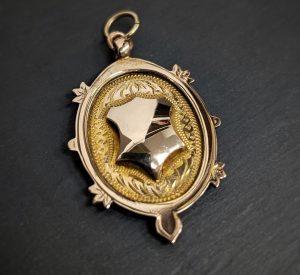
Over the years, many of these Albert chains have been lost to history, often melted down for their gold content. From an environmental perspective, this is a good thing. The need for newly mined gold is reduced as we recycle existing jewellery. But with each antique piece that is melted, a little bit of history is lost. And all of the hands it has passed through, and any imagined stories of its past, vanish along with it. Many Albert chains were hallmarked on each link, often with a date stamp. To wear an Albert chain is to wear a little piece of history.
However, all is not lost for the Albert chain. Many antique jewellery collectors have discovered a new value by repurposing it from its original use. An accessory once used most often by men is now enjoyed by both sexes, who wear Alberts as unique and characterful necklaces and bracelets. And the repurposing doesn’t stop there. The more decorative and dainty Albertinas are often worn in similar fashion, and the fobs that once adorned them are collected as pendants and charms.
Not only do Alberts and Albertinas create opportunities to be inventive and creative with how you wear jewellery, they are also accessible and friendly to all budgets. Alberts were used by people from all positions in society, and therefore they are available in a wide range of metals – from base metal and silver, to 9, 15, and 18 carat gold. Some were hollow to create more affordable gold options (although most that have survived are solid). They also vary drastically in design, from simple curb or figaro links to the highly desirable and extravagant box and fetter links adorned with stars.
Our passion for rescuing antique jewellery has allowed us to collect a versatile range of Albert chains over the many years we have been in business. It also means we have developed a strong eye for spotting the genuine antiques from their modern reproduction counterparts. Original, period Alberts are important, especially to antique jewellery collectors who are attracted to these items for their history and character. With our experience comes confidence in our ability to source genuine antique items.
All of the jewellery showcased in this blog is available, but we have many other options behind the scenes. If you’d like to know more about Albert chains and are considering purchasing one for your own collection, please reach out to learn more and let us know what you are looking for. We have a wide selection of fobs available too.
Our next blog will cover how we restored two of the Albert chains featured in this blog – so check back for more!
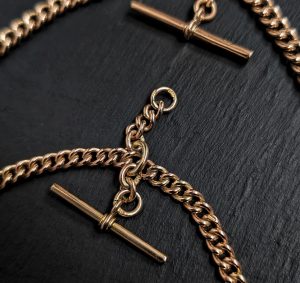
History and tradition form a large part of British culture and interest. It is therefore unsurprising that some of our most popular daytime television shows focus on antiques buying and selling, or that you can’t drive very far without passing an antique centre, or that there will always be some form of market or car boot sale held somewhere almost every weekend. Our love and appreciation for all things old has permeated our culture so wholly that it is considered a necessary part of our everyday lives.
For this, we are thankful. It allows us to pursue our greatest passion – rescuing and restoring antique jewellery. Antique jewellery collectors provide homes for historical pieces that would certainly be destroyed without a market (many still are) – and much history along with them. Value is generated through their character, increasing rarity, and story rather than simply their scrap metal price.
In our last blog ‘Repurposing Historical Jewellery: The Albert Chain’, we discussed the original usage for this familiar piece of jewellery, its downfall, and the recent upturn in popularity (no doubt thanks to the cultural love detailed above).
Of course, nothing will survive 100-150 years without a few wrinkles! A level of restoration is required to bring an antique piece back to its former self, to reveal its original beauty. Albert chains are no exception, and this blog details that process.
Let’s start with the basics – a good wash. Depending on its previous circumstances, objects requiring restoration can be covered in dirt or oils. It’s best to clean them with a simple soak or wash in warm water and washing up liquid. It’s surprising how well some century-strengthened dirt can cover essential hallmarks or stamps. These help to ascertain if an item is an original and authentic antique or a more modern reproduction.
As a reputable reseller, quality is of top importance to us. Once the item has been washed, it is closely examined to look for wear and damage. Not all Albert chains have the scars that betray their age – some are in remarkably good condition. If only worn for best, it may have spent more of its life inside a box than out. But others that faced regular use could show signs of wear or even have breaks in the links.
The type of metal plays a significant part in this; Albert chains were used throughout society by people from all different walks of life, and were therefore created to suit different budgets. Silver is an affordable metal, but a soft one, and joins between links may be more worn than with a 9 carat gold example – especially if the silver links were thin to begin with. But hardness of metal is no guarantee of durability; a hollow 9 carat gold example is likely to show more bumps and bruises than its solid silver counterpart.
Worn links may need to be built up, or broken links soldered back together. In some cases, chains are damaged beyond repair, but this isn’t as bad as it sounds… parts can be salvaged to restore others. Swivel clasps with broken mechanisms can be replaced with original antique examples rescued from other chains. We salvage everything we can – even if this is just a section of undamaged links. These allow us to extend Alberts for customers who wish to wear them as necklaces. Many Alberts are only just long enough to be worn this way. Our collection of parts allows us to make discreet and sympathetic alterations if required.
After assessing the condition of an Albert chain, and making any required repairs, the chains are polished. They face a more extensive clean in an ultrasonic machine that uses vibrations to loosen stubborn dirt and oil, alongside chemicals that undo the oxidisation process that causes metal to tarnish and become dull.
They are also polished on a wheel, a process that takes skill and technique to prevent accidental damage. Scratches in the metal are buffed out using a polishing wheel, or mop, that rotates at high speed. This gives the metal a mirror shine. It is essential to polish very small sections of link at a time, holding tight either side, to prevent the chain from being caught and wrapping around the wheel, potentially causing significant scratches and dents to the metal.
At the end of the restoration process, the Albert chain will look as it did when it was first made. Some 9 carat gold Alberts were gilded with rich, yellow gold to obtain the look of the more valuable higher carats (and this is why you can sometimes see bright yellow tones in the crevices of antique jewellery). This isn’t typically part of the restoration process; the coppery gold that hid beneath this vibrant top layer is appreciated (even preferred!) today for its soft colouring.
It’s wonderful to be able to revive jewellery in this way. Seeing an antique item fully restored to its original condition feels like looking back in time, with the faint, momentary hope that perhaps a long-lost story will be uncovered beside the bright shiny metal hidden beneath years of wear.
Many antique items pass through the hands of the goldsmiths in our on-site workshops and then move on to the next chapter of their lives. The ability to work on such a vast range of vintage and antique pieces has provided our goldsmiths with invaluable and extensive experience and knowledge, allowing us to confidently restore and sell authentic antique jewellery.
If you have an item of jewellery that requires repair or that you are looking to restore, please contact us and we will happily advise you. Alternatively, if you are here because you are looking to add an Albert chain to your collection, please get in touch! We have a large range in stock looking for new homes.
Join us next time to see how we restored a ring with a mysterious history that was found in the River Thames…
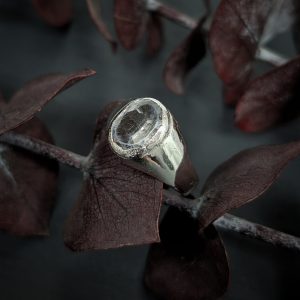
Originating from the 18th century, mudlarking was the act of searching for lost or discarded items on the banks of rivers in order to sell them. It was a task carried out by impoverished members of society trying to earn a living. And there would’ve been plenty to find… Before public rubbish collection systems had been established, rivers were often used by the surrounding city, town, or village to dispose of rubbish, and household and industrial waste. This caused significant damage to rivers in highly populated areas, such as the Thames, which is still recovering.
Today, mudlarkers are a little more like treasure hunters (depending on what your definition of treasure is, of course!) or archaeologists. They scour beaches and riverbanks looking for lost or discarded goods that can offer a small glimpse into local history. I have been a few times myself, and when you uncover a long lost item, you can’t help but wonder whose hands were the last to touch it before yours.
A customer recently brought us a signet ring that had been found in the Thames. It had been given a basic clean, but there was still mud stuck behind the stone. The silver ring was set with an oval rock crystal, and the metal was partially corroded and covered with black marks.
Establishing the age of the ring wasn’t easy. It was difficult to determine what were imperfections caused by early, rudimentary jewellery making processes and what was damage caused by decades amongst the mud, sand, and rocks of the turbulent Thames. Some elements, like the asymmetrical stone cut, were original and therefore could indicate significant age. Other parts were unclear; the irregular setting edge is often seen on older rings, but it’s impossible to be certain if it was caused by a naive manufacturing process, general wear, or from being buried. Adding further confusion to the mix, the style of ring and its weight held closer resemblance to more modern styles of signet rings.
A full restoration was possible, but our customer didn’t want the ring to lose all its hard-earned character, so the restoration process needed to be simple and careful. We could unset the stone, polish out any scratches at a lapidary, and rebuild the ring’s setting edge to be thicker and more uniform. But to do so would erase any remaining indications of its history, thereby destroying any chance of knowing even a part of its mysterious story. The customer decided on a clean and polish to remove the dirt wedged behind the stone and the most significant tarnish and corrosion from the metal.
It’s easy to dismiss the partial restoration due to the rings remaining ‘imperfections’. The stone is still scratched, the metal is still pitted, the setting edge is still uneven. But it’s important to recognise that all of these elements make up the ring’s unique history, and serve as a reminder that this is no usual signet ring, but a long lost, unearthed treasure with a secret past.
We will never know the truth behind this ring. Our best guess is that an old stone was set into a more modern ring around 100 years ago. But who wore it, and how it ended up in the Thames, will forever remain a mystery. Who knows what other secrets are hiding beneath the surface of this historical river; once a rubbish dump, now a mudlarker’s paradise. Perhaps it’s not the promise of treasure that draws people in, but the ability to storytell, to imagine a life gone by, and a personal connection to someone from the past. A thread from one hand to another, back through time.
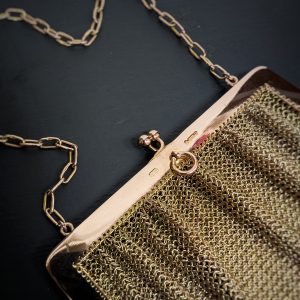
Mesh bags have existed in some form since the Georgian period, but the peak of their popularity would not be realised until almost 100 years later. The style is thought to have originated during the industrial revolution. The rapid increase in pollution in the country’s major cities left many unhappy with the advances in technology and production. This inspired a number of artistic movements that each produced distinctive designs linked by a common ideology; they rejected the acceleration into the future and searched for inspiration in the simpler times left behind, either via manufacturing processes or aesthetics. One of these artistic movements was greatly influenced by the Middle Ages. The chainmail armor once worn by medieval knights would go on to inspire their antithesis – fine chainmail had a fabric like quality, ideal for crafting bags and purses made from gold and silver.
The version of chainmail bag we are most familiar with today is attributed to a United States jewellery manufacturer called Whiting & Davis. They are credited with designing the first purse of this style in 1892, approximately 50 years after the Victorian medieval revival in the UK. This niche area of history is a little murky, as reputable auction houses in the UK have sold similarly designed chatelaine purses purportedly from the Georgian period, 100 years prior. Of course, it’s possible they drew inspiration from this earlier design period. But regardless, this desirable accessory soon became a far more significant part of the Whiting & Davis brand than it ever was for the medieval revival period. Chainmail bags became the centre and signature of Whiting & Davis products.
At first, they were an expensive and exclusive item, boosting their popularity. To satisfy low-budget demand, manufacturers began creating low-grade silver and base metal examples. But there was a problem – each bag had to be entirely crafted by hand. Yes – all of those tiny little rings were hand assembled! This really limited production, and the steep cost of labour meant retail prices remained high even when less valuable metals were used.
Whiting & Davis, unable to fulfill production demand alone, had to battle the increasing number of competitors now flooding the market. But they were working on something behind the scenes that would put them at the forefront of production once more. In 1909, they filed a patent for a machine that automated the production of the chainmail. This invention marked the end for many of their competitors, who simply couldn’t keep up with their output.
By now, chainmail bags had been on the market for almost 20 years; they were no longer a new and exciting must-have accessory. Whiting & Davis, having invested in improvements to the manufacturing process, were eager to keep the trend alive so that their innovation and hard work would prove worthwhile. The newly automated production allowed them to focus their attention on developing unique designs that kept the purses relevant in the demanding and constantly evolving fashion industry. They were successful in this endeavor, and still produce mesh bags today – over 100 years later!
The extensively recorded history of Whiting & Davis has helped shine a rare light on the journey of our own gold chainmail bag. Ironically, so many vintage and antique collectors love old items because of their history and story, despite the fact they are unlikely to ever uncover them. Fortunately, that is less of the case in this instance, and the bag is marked with a number of useful clues that give insight into its fascinating past.
It is hallmarked for 1908, the year prior to the invention of the automated machine. It’s amazing to think the hundreds of tiny hoops that form the mesh were therefore painstakingly assembled by hand; a fact that gives the bag even greater appeal and solidifies its part in the history of jewellery making. The hallmark includes an import mark, meaning the bag was not manufactured in the UK. We’ll never know for certain where it began its life, but it’s possible it was manufactured in the United States and shipped to the UK, creating an even stronger connection to the history detailed above.
This 9 carat gold bag is in beautiful condition; the fact it has survived so well for so long is testament to the skills of the people who dedicated so much time to its production. Our new-found knowledge has given us a refreshed appreciation for it – we hope you feel the same way!
You can find out more about the bag featured in this blog here.
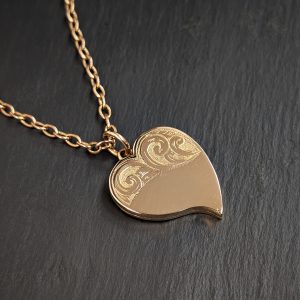 The Heart and the Hallmark –
The Heart and the Hallmark – On first glance, this necklace may appear as just another, unassuming heart locket. But don’t be fooled, there is much more to this than meets the eye. One small detail differentiates it from your average heart locket – a curve in the tail. And a letter in its hallmark only adds to the mystery. With very little to go on, is it possible to unravel the real story behind this unique necklace?
A heart with a curved point is known as a ‘witch’s heart’. It was first used in jewellery in the 17th century. It’s difficult to know where the design originated, as it appears in several different places including North America and Scotland. The Scottish version is known as a ‘Luckenbooth’, and it remains a popular symbol in Scotland today. Initially, it was used as a talisman for safety and protection from evil spirits. They were particularly popular gifts for new-born babies; it was believed that leaving the emblem near an infant would keep them safe from harm.
Over the following century, the meaning behind the symbol evolved. This style of heart was often associated with marriage, particularly examples with two hearts linked together. They were deeply romantic gifts, and signified a wearer ‘bewitched by love’. The design and the sentiment behind it was so popular it even reached royal circles; Mary, Queen of Scots is said to have gifted a Luckenbooth brooch to Lord Darnley.
As with most trends, over time the witch’s heart began to fade. During the Victorian era, hearts with the characteristic, curved tail were replaced with a less defined heart shape, similar to an upside-down pear. Queen Victoria was a serious trendsetter, and her relationship with Prince Albert defined a whole new era of design – the Victorian Romantic period. Eventually, this soft, somewhat ambiguous heart evolved into the more familiar shape recognisable to us today. The distinctive witch’s heart had long fallen out of favour, and the design never reappeared.
Although this history helps us to appreciate part of the locket’s story, it also calls into question why it bears the characteristic of a design rarely seen in England for 200 years prior to its creation. Luckenbooth jewellery remained relatively popular in Scotland, but it had lost the distinctive curved tail in favour of a long, straight shape instead. Regardless, we know from the hallmark that the locket is not of Scottish origin – it was manufactured in or around Chester.
There is important historical context that may help unveil how this unique locket came to be. Hallmarked with the date stamp for 1915, the locket was manufactured during the First World War – a time when jewellery production was drastically reduced in order to turn all energy and attention towards the war effort. The locket is made from relatively thick gold sheets, giving it a fairly substantial weight, but this was unusual for the time. Gold stocks were diverted for use in trades for ammunition, food, and other essentials – understandably, jewellery was not a priority! Any gold jewellery that was produced was often lighter in weight and of simpler design. Wearing extravagant jewellery was frowned upon, unless it was a memento piece, such as a locket.
Unsurprisingly, memento jewellery grew in popularity during wartime. Lockets and sweetheart brooches were worn by many women in honour of friends, family, and loved ones away at war. They would be purchased or given as gifts before soldiers were deployed to the front line, and treasured whilst awaiting their return. Born from a hope for a better future and an end to the horrors of war, love became the prevailing sentiment, and this was reflected in the jewellery people chose to wear.
Often, a sense of romance accompanies the World Wars; hastily planned weddings, last kisses at train stations, and anxious love letters. The purpose of memento jewellery was to keep a piece of those desperately far away a little closer to home. But not everyone was lucky enough to return, and any romantic notions belie a much darker, sadder reality. For many, these trinkets of hope would become ornaments of mourning and remembrance.
I am fortunate that there is much to be learned from this beautiful necklace. In combining all elements, it is possible to piece together a fascinating history. Firstly, it is a locket produced in a time of war. It’s therefore likely to have been owned by someone whose loved one fought in World War 1. This is nothing unusual given the preference for this style of jewellery at the time. It is, however, large, heavy, and made of gold, which is unexpected for a time when gold was scarce and the jewellery trade was limited. Is it possible that this necklace represented a sentiment of such importance to the buyer that they felt only something of great quality and expense could truly express it, even (or, perhaps, especially?) in a time of war? Was it produced in defiance of all the surrounding turmoil in order to make a statement? Secondly, it resurrects a symbol of love seldom seen in England in the previous two hundred years. A symbol of deep affection. And this is where the story offers two possible options.
Initially, the ‘witches heart’ was used as a talisman to protect newborns from evil spirits. Could this necklace have been commissioned to represent a Mother’s love? Did it once carry the photo of her beloved son in the hopes it would protect him from the evils of war, and bring him home safely?
Or, was it created as a gift to symbolise the profound and bewitching love between a soldier and his sweetheart while he was away? Was this a gift of deep significance and sentimentality born from the belief that through all the horrors and heartache of war, their love would prevail?
Imagining the life of antique jewellery before it reached your hands is a huge part of the attraction of collecting it. All antique jewellery lovers have to come to terms with the fact it’s unlikely they will ever really know the exact history of any piece in their collection, but never have I felt so desperate to unearth the secrets of a piece of jewellery as this one.
It is easy to disregard jewellery as little more than a fashion accessory, but it has formed a significant part of human expression and culture for thousands of years. Even in the face of devastation as severe as is seen in World Wars, we turn to jewellery to provide solace, to express hope, and to honour those who have fallen. Unfortunately, the truth behind this piece will forever remain a mystery… But using the clues left behind, a little bit of knowledge and historical research, and a touch of imagination, it is possible to build a story – and if you’re lucky, one special enough to satiate the thirst of curiosity.
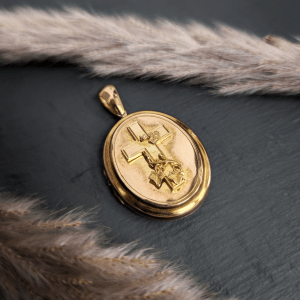
Before we had words, we had pictures. From paintings on cave walls to emojis in text messages, symbols have always been a core part of human communication. They can be a quick way to send a message, and also a discreet one, with only the initiated able to uncover their true meaning or to even notice something is being said at all.
The Victorians were a reserved society, but a deeply sentimental one. Social convention discouraged open communication of thoughts or emotions, so the Victorians turned to symbolism as a more discreet form of expression. Symbols became a significant part of art and literature, but also daily life. Victorian floral symbolism, known as floriography, became so complex that manuals were published to explain the message conveyed in an otherwise unassuming bouquet.
Queen Victoria was a popular and influential monarch who put jewellery at the forefront of fashion, and the appreciation and necessity for subtle symbolism pervaded jewellery design. Acrostic jewellery is a perfect example; a ring set with an unusual combination of gemstones may relay a message when the first letter of each gemstone is put together. Diamond, emerald, amethyst, ruby, emerald, sapphire, and topaz would translate to ‘dearest’.
Death was a prevalent part of life. Morbidity rates were high. As a result, mourning was an important part of Victorian culture. People were expected to follow strict mourning rituals that defined everything from who one should mourn (and the circle was wide!), the length of period of mourning, and acceptable dress code. Victorian mourning jewellery is a style in its own right, with such versatility it would be possible to devote an extensive collection just to this subset. Although the motifs used to represent death or remembrance weren’t especially difficult to decipher (coffins, skulls, or gravestones), symbols were often combined to convey deeper meaning, and context was important.
In our blog about our WW1 heart locket, I discussed the appeal of antique jewellery to collectors. I suspect many of us have vivid imaginations and are drawn to these old pieces by the lure of an unknown history. Sometimes, with a bit of luck and detective work, we are able to piece together a story that satisfies our curiosity until we find another piece bearing enough clues to offer a fresh starting point.
Not much deduction is required to ascertain the purpose of this locket. Lockets are sentimental pieces, and this, in combination with a cross, means it was likely used in remembrance of a lost loved one. But there is one last titillating detail that unearths more of the story – the ivy.
‘Close clings the ivy to the tree
So in my heart I cling to thee’
Ivy was a popular symbol in the Victorian era. There was a growing interest in the natural world, and in particular botany, which was an accessible scientific field to study. Little equipment or knowledge was required to identify plants, and samples were readily available – you only had to step outside. So it’s unsurprising that subjects like floriography grew in popularity, and that different meanings were attributed to various plants and flowers.
The above Victorian rhyme can help explain why ivy evolved its meaning. Ivy becomes almost inseparable with what it grows on, and so its behaviour determined what it represented. It became the embodiment of everlasting love and marriage, binding two people for eternity, and was a common motif on wedding rings. It had religious connotations too, as ivy always grows upwards to heaven.
To wrap ivy around a cross is an evocative image. The cross resembles a gravestone; still, sombre, unresponsive. Meanwhile, the living ivy, its organic, curved lines juxtaposed against the stiffness of the cross, wraps its way around heavenward, desperately clinging on. It’s an emotive message of loss and longing, and one that paints a picture of the circumstances of the locket owner.
Ivy as a symbol of eternal love and marriage, suggests a romantic relationship between the locket owner and the person it was intended to tribute. Most likely, it was worn by a widow in remembrance of her lost husband. It may have originally held a photo or perhaps even some hairwork. The ivy could have represented her devotion, or the strength of their bond and the depth of her loss in a time when publicly asserting her sorrow wasn’t possible. The locket would’ve offered an outward expression of her grief, and acted as a memorial she could carry with her everyday.
Despite the tragic circumstances that surround the locket, there is a beauty in the poetic nature and openness of the Victorian’s approach to grief and mourning, and the romantic and impassioned language and symbolism used to describe love. When considering the popularity of mourning jewellery and ivy as a symbol, there is nothing subtle or disguised about the message expressed here. Despite being produced in an era that encouraged emotional restraint, the locket’s depiction of loss and the sentiment behind the imagery is overt and powerful. We can only hope it provided some source of comfort to the owner.
The enduring quality of jewellery clearly cannot be understated. Although designed as a tribute to a lost spouse, through time this locket has evolved to memorialise the love shared between two people. Their names are lost to history and we have only a small glimpse of their story, but despite all that has been lost, their love has survived, and their feelings for one another are still inspiring curiosity and understanding over a century later.
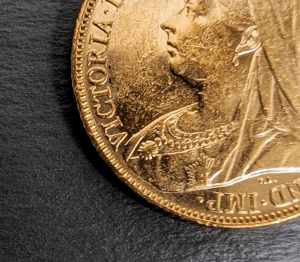 Why Gold is Worth Every Penny
Why Gold is Worth Every PennyThis blog isn’t about gold as an investment, it’s about gold as a cosmic treasure. Of course, it’s no secret that the price of gold keeps on rising. Although it may have an occasional dip in value, overall it has followed a reliable, upwards trajectory and proven itself as a worthwhile investment. Hence why everyone is still rushing to buy it despite recent spikes raising gold to prices never seen before. But even outside this intrinsic value, gold is a rare commodity with a fascinating origin story that makes it worth every penny.
Pure gold is highly resistant to tarnishing and corrosion. If you are lucky enough to find an old gold coin in the ground, it isn’t difficult to establish what it’s made of. Gold can sit in the ground for hundreds of years and, when it is unearthed, look as bright and shiny as the day it was lost. The first people to discover gold were as captivated by this striking metal as we are today; it quickly became an integral part of civilisation, and was used in trade, fashion, decoration, and had social applications, such as establishing hierarchy or status.
But none of the gold present on Earth was formed here. Not only does it predate Earth, it predates our entire Solar System – it formed billions of years ago. It takes a huge amount of energy to create gold – the kind of energy generated by stars, either in death (known as a supernova), from the collision of neutron stars, or from the flare of a highly magnetic neutron star known as a magnetar.
When stars die, they explode. This creates a phenomenal amount of energy – enough to produce heavy elements like gold, which are then propelled into space to gather in clouds made of gas and dust called nebulas. These nebulas can go on to produce solar systems, as was the case with our own. The planets that form are built from the elements present in the nebula, including gold. From the very beginning, gold was part of the Earth’s makeup.
The gas and dust cloud that formed our Solar System is known as the Solar Nebula, and any gold within the Solar Nebula that helped to form Earth would likely lay very deep within its structure, far beyond our reach. Some have theorised that the gold we mine from the Earth’s crust either arrived as part of meteorites or was displaced from the lower layers by a bombardment of meteorite collisions around 4 billion years ago. Either way, the gold that human beings have treasured for millennia and used to craft trinkets, talismans, jewellery, and much more, is exceptionally old and has travelled incomprehensible distances across our galaxy to reach us.
This certainly sheds a new perspective on gold jewellery. That familiar yellow metal that wraps around your finger or hangs from your neck has an unfathomable history. It’s impossible to picture the journey from its creation to where it resides now; flung from a star, it travelled through space to a nebula that formed a planet capable of sustaining life. Life that evolved and discovered it. Life that sensed value without knowledge. Life that appreciated things simply because they were beautiful and provoked wonder. No doubt drawn by its rich and vibrant colour, we decorated ourselves, our books, and our buildings with it. It has captured our interest and curiosity for so long that we have advanced enough to investigate and study its origins. And what we have found is nothing short of magical.
Gold has an inherent value that makes it a solid and reliable investment. But it’s a fascinating metal in its own right, with an amazing astronomical history and a significant human one. This adds more depth and meaning to gold jewellery – way beyond that of investment. Because it isn’t just coins, bullion, or jewellery. It’s made out of stars.
If you are interested in investing in gold sovereigns, Krugerrands, gold bars, or gold bullion, please get in touch here.
Alternatively, if you are looking to take advantage of gold prices by selling your jewellery or coins, we buy gold. Please get in touch with us here for more information.